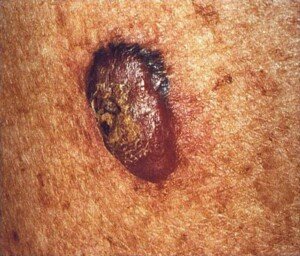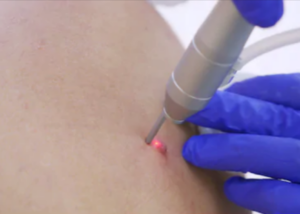
No, this is not a suspicion of melanoma based on looking at the skin with a dermatoscope, but actual DIAGNOSIS via a special laser microscope.
This groundbreaking technology is called multiphoton microscopy.
Not only can melanoma be detected with this new technology, but so can basal cell carcinoma, the most common skin cancer (and the most common overall cancer).
The technology comes from the National Institute of Biomedical Imaging and Bioengineering and has the “potential to make detection of skin cancers extremely rapid at very early stages,” explains the report.
Conventional Method of Diagnosing Melanoma
• Doctor removes part of or the entire suspicious lesion.
• The tissue is sent to a lab where a dermapathologist will view it under a microscope.
• The results can take days to come back.
Multiphoton Microscopy
• Patient’s skin is viewed through the special microscope.
• Diagnosis is made within minutes.
How does this work?
Mitochondria are structures found in all cells and are responsible for generating energy.
When melanoma is present, these little powerhouse organelles behave differently.
Inside a mitochondrion is a molecule called nicotinamide adenine dinucleotide (NADH).
NADH can be detected with multiphoton microscopy.
The laser microscope can show at very high resolution individual cells — without a pathologist having to thinly slice them for viewing as is done via the conventional biopsy.
Mitochondria are spread like a web through a cell.
A different pattern with the mitochondria, however, is revealed with the cancerous cells, states the paper. The mitochondria show in “clumps or clusters.”
Study Results
• The technology correctly identified cancer in the 10 subjects who had melanoma or basal cell carcinoma.
• The technology also correctly revealed healthy tissue in the four subjects who did not have skin cancer.
A larger-scale study is needed to see if this 100 percent accuracy for such a small study group extends to larger numbers of people.
The technology may be available in doctors’ offices within five years (as of 2017), but the caveat is that the laser costs $100,000.
Hopefully there will be a way to significantly reduce this cost so that melanoma can be diagnosed within minutes without a biopsy.
2023 update on multiphoton microscopy: There hasn’t been any significant advances other than a few additional studies showing similar results.
It may be many years before this technology begins replacing conventional biopsies for suspected melanoma on a wide scale.
Melanoma Is Highly Curable when Caught Early
“Early detection is crucial for treating skin cancer, as it is much easier to treat when caught in the early stages,” says Alberto de la Fuente Garcia, MD, a board certified dermatologist at VIDA Wellness and Beauty with 15+ years of experience.
“Additionally, regular skin exams can also help to identify underlying problems that may increase your risk of developing skin cancer in the future.
“For example, if you have a family history of skin cancer or excessive sun exposure, your doctor may advise you on steps to take to reduce your risk.”

 Dr. de la Fuente Garcia
Dr. de la Fuente Garcia







































